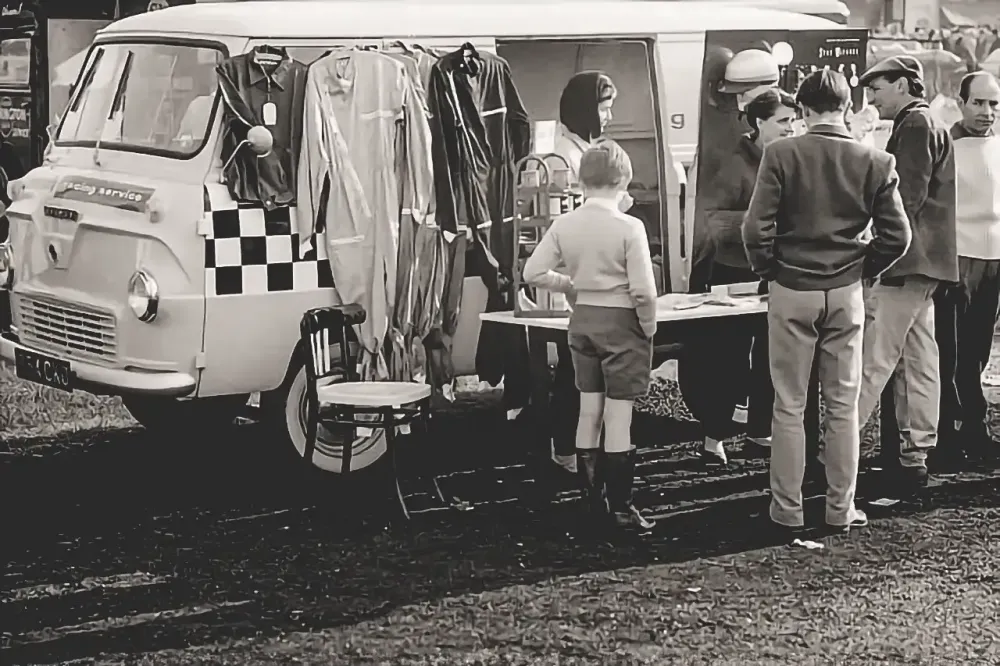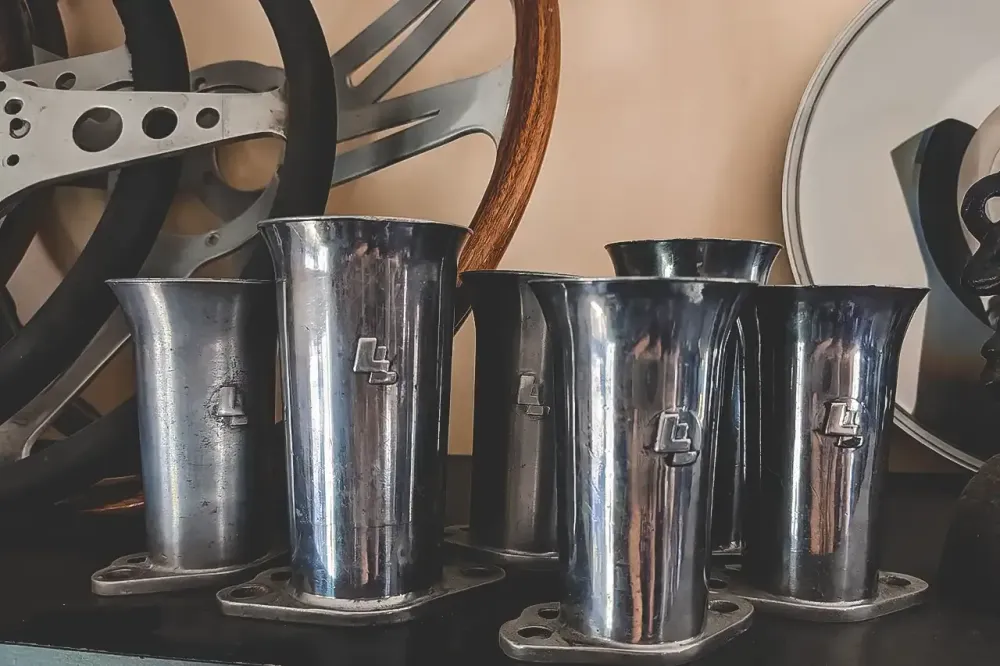Les Leston, the racewear “influencer”
Today, when we talk about sports steering wheels or accessories for racing, we remember brands like Sparco, Momo, etc. But in the 50s and 60s, anyone who wanted to have a properly geared car had to have a Les Leston steering wheel, if possible to handle with driving gloves by the same brand.
Born in 1920 as Alfred Lazarus Fingleston, he was the son of a Lithuanian descendant, a coal businessman, who saw his business collapse in the mid 20s, so he moved with his family to the outskirts of London and changed their surname to Leston and his son's name to Les.
As a teenager, Les became a self-taught drummer, dedicating himself to jazz with great success, having joined several renowned bands. An artistic trajectory that was interrupted by the war. He served as an artilleryman, having risen to Sergeant in his military career. After the conflict, he and his father founded a business selling aviation components and accessories.
It was only at the age of 29, that Les began racing, with an outdated SS100, soon moving to single-seaters. In 1951 he competed in British Formula 3 with a Keift, having achieved several podiums, even beating drivers like John Cooper.
The following year he was F3 Hillclimb Champion and won the Luxembourg Grand Prix, beating, among others, Stirling Moss and Peter Collins. Over the years, he amassed outstanding results in F3 and F2.
His talent was noticed, becoming an official driver for Aston Martin and Connaught.
Sharing the DBR1 with Roy Salvadori, he finished sixth in the Nürburgring 1000km and retired from the 24H of Le Mans. In non-championship Formula 1 races, Leston achieved several important results, competing with top professional drivers.
In 1958 he ventured with his Riley 1.5 in rallying and in the British Touring Championship, having won the class in the first race in which he participated. In the following year, he would become champion in the B-class.
A business started by... accident
Still in 1958, Les Leston had a serious accident while driving a Lotus XII on the Caen circuit. A mechanical failure caused the violent crash, but with the only ambulance on the circuit occupied, Leston remained waiting for help for an agonizing 14 laps.
From then on, his career would focus on the uniform brand he had maintained for some time. The Ford Thames 400E van from Leston’s Racing Service was a constant presence on the circuits. The first products were the steering wheels and selector knobs but, progressively, Leston would focus on the pilots' equipment: helmets, gloves and, mainly, full overalls, which at the time were a complete novelty.
Safety and a paradigm shift
In both competition and street cars, Les Leston left its mark, spreading quickly, with very well designed and manufactured products, particularly the beautiful wooden steering wheels. Leston was also Speedwell's agent and simultaneously supplier.
However, Les Leston's greatest legacy would be in driver’s safety, having become a pioneer in fire-retardant suits.
It all started when Les Leston decided to produce overalls that were soaked in a combustion retardant product, created for West End theater curtains. He would later be responsible for introducing fabrics such as Protex and - still used today - Nomex into cracing.
Leston proved to be an excellent marketeer, investing on an effective campaign to promote his products, featuring Graham Hill and also Peter Proctor, an English driver who, at Goodwood in 1966, was seriously scarred by flames, having sustained third degree burns over 65% of his body.
Proctor, who remained a prominent figure in racing, decided to take part in a Les Leston advertisement, in which his face appeared in the foreground. The ad copy said something like:
“‘My name is Peter Procter. I would like to tell you about a new flameproof material for racing drivers.”
After a brief description of the product’s features, he concluded with:
“One last thing: you may find it distasteful that I appear in this ad. My reason is this: pilots are not required to wear fireproof clothing in this country; you can run in a t-shirt if you want. I think it should be mandatory to wear properly designed protective clothing, and if I can persuade even one pilot to improve their safety standards, I think my appearance has been justified.”
Peter Procter ended by explaining that the money he received for featuring in the ad would be donated to the “McIndoe Burns Unit”, an institute dedicated to the research and treatment of burn injuries.
Radio, TV and Hong Kong
Charismatic, well-connected and knowledgeable, Les Leston would end up being recruited by the BBC, at the end of his career, to comment on races and conduct interviews.
At the end of the 70s, Les Leston stopped producing accessories, dedicating almost exclusively to promotional racewear, having closed the famous store at Finchley Road, in London.
He later moved to Hong Kong, where his business continued with some success, manufacturing in China, while keeping several good contracts in Europe.
However, in the 90s Les returned to the UK, where he lived until the end of his life. He died in 2012, after a long period of illness.
Collectors items and a second life for the brand
In recent years, Les Leston's grandchildren, very active in the world of vintage cars, have expressed their desire to revive the brand. However, to date, they have produced little more than some merchandising.
The brand, however, persists in the memory of enthusiasts, with a huge community of fans of Les Leston accessories.
At autojumbles, online websites and auctions, the brand's accessories continue to be traded for high prices. Steering wheels, gear-knobs, rear-view mirrors, clothing, gloves, key rings, among others, are true collectable items.



















